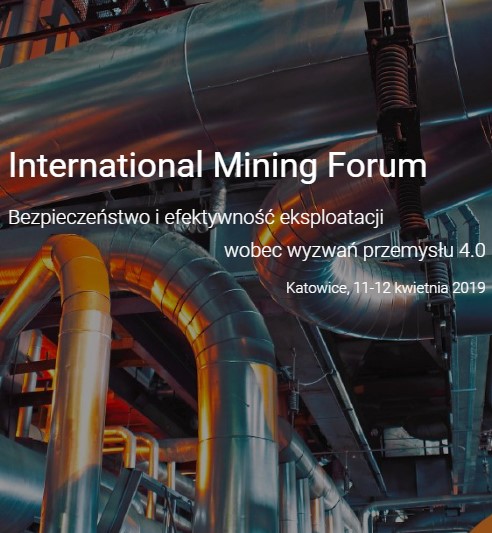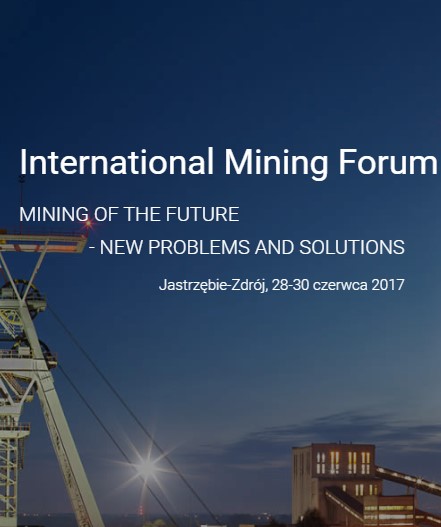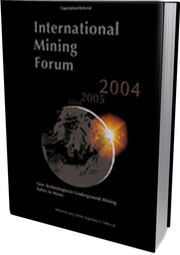Technological Features of Mining in View of Geometrical and Physical Parameters of Stress Fields' Borders
Volodymyr I. Bondarenko
National Mining University. Dnepropetrovsk, Ukraine
Roman O. Dychkovskiy
National Mining University. Dnepropetrovsk, Ukraine
Approaches to Systematic Mine Closure and Mine Site Rehabilitation in the Baia Mare Mining District, Romania
Nicolae Bancila-Afrim
North University of Baia Mare. Baia Mare, Romania
Christian Buhrow
TU Bergakademie Freiberg. Freiberg, Germany
Dorel Guşat
TU Bergakademie Freiberg. Freiberg, Germany
Adalbert Kruk
"Vamera" S.R.L. Baia Mare. Baia Mare, Romania
Martin Peterfi
North University of Baia Mare. Baia Mare, Romania
Potencial for Use of Pneumatic Constructions in Underground Mining
Volodymyr I. Buzilo
National Mining University. Dnepropetrovsk, Ukraine
Volodymyr S. Rahutin
National Mining University. Dnepropetrovsk, Ukraine
Volodymyr P. Serdjuk
National Mining University. Dnepropetrovsk, Ukraine
The Influence of Microstructure and Mineral Ingredients in Coal on Its Spontaneous Combustion
He Qilin
Anhui University of Science & Technology. Huainan , Anhui, China
Yuan Shujie
Anhui University of Science & Technology. Huainan, Anhui, China
Wang Deming
China University of Mining & Technology. Xuzhou, Jiangsu, China
ABSTRACT: For different ranks of coal or coal with the same coalification degree but different susceptibility to spontaneous combustion, the S250MK3 scanning electron microscope was used at different amplifications to observe their overall appearance, pores and fracture distribution. The observation by the S250MK3 scanning electron microscope combined with the mineral composition ascertained by the mineral substances energy spectrum analysis elicited the conclusions: coal with different coalification degree has significantly different porous structure; the porous structure of coal is the main factor determining the quantity of oxygen absorption by coal at low temperatures, which has certain effect on susceptibility of coal to spontaneous combustion. The research also found, that sulfur content and its different occurrence in coal is the main cause resulting in different susceptibility to spontaneous combustion of coal with the same coalification degree.
KEYWORDS: Scanning electron microscope, microstructure of coal, oxygen absorption, spontaneous combustion susceptibility
Some Aspects of the Coal Industry Sustainable Development in China
Yuan Shujie
Anhui University of Science & Technology. Anhui Province, China
ABSTRACT: This paper presents the present situation of the coal industry in China, the issues of coal resources, work safety in coal mines and environmental protection, which influence the coal industry's sustainable development. The author gave some policy proposals for the Chinese coal industry sustainable development.
KEYWORDS: Coal industry, sustainable development
Estimation of Environmental Impacts of Mining Technologies
Carsten Drebenstedt
Technische Universität Bergakademie Freiberg. Freiberg, Germany
Pierre Schmieder
Technische Universität Bergakademie Freiberg. Freiberg, Germany
INTRODUCTION
The close vicinity of mining companies to other sites that are used for commercial and residential purposes or to areas under conservation as well as the fact that the people become more and more sensitive to emissions have led to a negative attitude towards mining operations in the neighborhood. It is above all the use of drilling and blasting techniques that give rise to objections, in the course of which demands for more environmentally-friendly production methods have been voiced. It is in this context that production methods without the use of explosives are considered as an option. After all, the use of such production methods is the only alternative for some quarry operators. The question is what are the true benefits of these techniques and what is the relation between a possible improvement of the environmental effects on the one hand and the technological potential as well as the costs on the other.
It is intended to assess the mining techniques for solid rock in their entirety. This paper will therefore look at the aspects for assessing mining techniques in the context of their environmental impact and the costs.
Royalties as the Tool of Raw Material Policy of the European Union Countries
Jaroslav Dvoøáèek
VŠB - Technical University of Ostrava, Faculty of Mining and Geology. Ostrava, Czech Republic
ABSTRACT: The sustainable development is connected with intensity of raw materials exploitation. This intensity depends on raw material policy of particular state that is influenced by conditions of granted mining rights and licences including the mining royalties. The contribution deals with the problem of royalties in "old" and "new" European Union countries as a part of their raw material policy.
KEYWORDS: Raw material policy, mining legislation, royalties
Optimization of Interaction in the "Anchor - Rock" System
Irina A. Kovalevska
National Mining University. Dnepropetrovsk, Ukraine
Viacheslav V. Porotnikov
State company "Alexandriacoal". Ukraine
A Life Cycle Assessment of Electricity Production from Hard Coal
Jyri Seppälä
Finnish Environment Institute. Helsinki, Finland
Laura Sokka
Finnish Environment Institute. Helsinki, Finland
Sirkka Koskela
Finnish Environment Institute. Helsinki, Finland
Joanna Kulczycka
Polish Academy of Sciences, Mineral and Energy Economy Research Institute. Cracow, Poland
Malgorzata Goralczyk
Polish Academy of Sciences, Mineral and Energy Economy Research Institute. Cracow, Poland
Karol Koneczny
Polish Academy of Sciences, Mineral and Energy Economy Research Institute. Cracow, Poland
Anna Henclik
Polish Academy of Sciences, Mineral and Energy Economy Research Institute. Cracow, Poland
ABSTRACT: Since coal is a fossil fuel used commonly for electricity production in the world, life cycle assessments (LCAs) of products and services usually require data on the environmental burdens of electricity production from coal. In an EU Life-Environment project called OSELCA, one task was to create LCA data on electricity production from hard coal and oil shale in order to compare the environmental performances of these two electricity sources. For this purpose, an LCA of hard coal electricity was carried out. The aim of this article is to give a general view of the emissions and environmental impacts caused by the various life cycle stages of hard coal electricity on the basis of the LCA study. The production system consists of hard coal mining in Poland, a power plant representing the best available technology in Finland, and all the main processes related to mining and the power plant. The emissions of the electricity system were assessed and analysed from the point of view of different impact categories. For acidification, tropospheric ozone formation and terrestrial eutrophication, the country-dependent characterisation methodology of LCA was used. The results showed that the power plant stage is a major life cycle stage causing climate change, acidification, eutrophication and heavy metals to air (except for Hg). The coal mining causes 95% of the non-recovered wastes of the whole production system and it contributes most to the effects of tropospheric ozone formation due to methane emissions. Also external electricity and heat production for mining and coal transportation are important contributors to tropospheric ozone formation, acidification, eutrophication, particulate matter and some heavy metals (Cu, Ni and Zn) to water.
KEYWORDS: Coal, electricity, environmental impact assessment, life cycle assessment (LCA)
Determining the Design and Parameters of Straight Cylinder Burn Cut in Development Workings
Garry G. Litvinsky
Donbass State Technical University (DonSTU). Alchevsk, Ukraine
Pavel Shulgin
Donbass State Technical University (DonSTU). Alchevsk, Ukraine
ABSTRACT: The basic information about cylinder cuts used in mine works are given. The advantages of cylinder cuts are shown. The purpose of research - development of design and determination of parameters of straight cylindrical burn cut. Design features of cylinder cut and a principle of its work at explosive destruction of rocks are considered. Cut parameters are investigated, calculation formula for its radius depending on major factors is offered. Recommendations for practical application of cylinder cut are given, its advantages are shown.
KEYWORDS: Drilling and blasting operations, cylinder burn cuts, design of cylinder cut, parameters of bore-holes, calculation methods, factors' valuation, application recommendations
Separation of Roof Rock Observed in Headings Under Development
Tadeusz Majcherczyk
AGH - University of Science and Technology. Cracow, Poland
Piotr Małkowski
AGH - University of Science and Technology. Cracow, Poland
Zbigniew Niedbalski
AGH - University of Science and Technology. Cracow, Poland
ABSTRACT: The paper presents a methodology of measurements and results of selected evaluative techniques of roof rock separation in headings driven in coal-mines. The results quoted were obtained by measurements done specifically for the purpose, whose aim was to determine movement of the rock mass around the headings. The extent of separation depends on the type and physical qualities of roof layers, mining conditions, and type of support applied in the heading. Due to changing mining and geological conditions around the controlled heading, the evaluation of separation should be carried out in its longest section. This allows for an appropriate evaluation of the fracture zone around the tunnel and then may become a base for the determination of load exerted by the failed roof rock on the installed support.
Use of Mineral Coal for Sorption Sewage Treatment
A.V. Mozolkova
Russian University of People's Friendship. Moscow, Russia
E.V.Chekushina
Russian University of People's Friendship. Moscow, Russia
A.A. Kaminskaya
Russian University of People's Friendship. Moscow, Russia
Assessment of the Accuracy of Ground Movement Elements Prediction Using Simulation Method
Wojciech Naworyta
AGH - University of Science and Technology. Cracow, Poland
Joachim Menz
Technische Universität Bergakademie Freiberg. Freiberg, Germany
Anton Sroka
Technische Universität Bergakademie Freiberg. Freiberg, Germany
ABSTRACT: Method to calculate movement elements of ground and ground surface, based on simulation approach was presented in this study. The method assumes that the parameters of the theory describing properties of the ground are treated as random functions. The method allows to calculate the most probable course of any movement element, to assess its confidence interval and probability that the value of movement element will exceed assumed critical values.
Study of Dust Pollution in Slate Processing Plants. Integration of the Results into a GIS
C. Ordónez
University of Vigo. Department of Natural Resources and Environmental Engineering. Vigo, Spain
J. Taboada
University of Vigo. Department of Natural Resources and Environmental Engineering. Vigo, Spain
M. Araújo
University of Vigo. Department of Natural Resources and Environmental Engineering. Vigo, Spain
ABSTRACT
In the history of mining, especially of coal, the dust produced by minerals and rocks has proved highly noxious to humans, causing illnesses such as silicosis, which, until recently, was a prime cause of death among miners. However, although studies of these negative effects on humans have mostly focused on underground coal mining, this kind of dust is also produced in mineral and rock processing plants, such as those for producing slate and granite. Galicia (Northwest Spain) is one of the world's main producers of granite and slate.
We studied dust contamination in a number of Galician slate production plants, some of which have existed for a number of generations and others, which are more recent. Dust concentration measurements were made for four particle sizes (0.5 ľm as the maximum diameter) at different points of the plants, but particularly in the areas where people worked. Other variables that positively or negatively affected dust levels were also taken into account, such as noise levels or the existence of dust extractors. These data were then used to devise, using multivariate statistical methods, an environmental quality index that represented the level of contamination for each sampled point as a single value. In this way the most problematic working locations could be identified, with a view to implementing measures designed to reduce plant contamination levels. The results were represented in contamination maps constructed using kriging interpolation and integrated in a GIS (Geographic Information System) together with information on plant machinery, the kind of work performed at each location, and the characteristics of a dust extractor installation designed to reduce operator exposure to the dust generated by the slate-working processes.
Environmental Aspects of Mine Closure - Polish Experience
Jan Palarski
Silesian Technical University of Gliwice (STU), Faculty of Mining & Geology
Institute of Geotechnology, Geophysics & Ecology of Industrial Areas. Gliwice, Poland
ABSTRACT: The results obtained from the monitoring program of mine closure and post-closure processes are presented in this paper. The objective of the article is to evaluate how mine closure and rehabilitation can be best designed in order for the mine to contribute to the long-term sustainable development of mining sites. Mine closure plan should include site closure issues as well as environmental, economic, social and employee matters.
KEYWORDS: Mine closure, sustainable development, rehabilitation, water contamination
Scientific Problems of Coal Deposit Development in Ukraine
Gennadij G. Pivniak
National Mining University. Dnepropetrovsk, Ukraine
Volodymyr I. Bondarenko
National Mining University. Dnepropetrovsk, Ukraine
Petro I. Pilov
National Mining University. Dnepropetrovsk, Ukraine
Development of Basic Criteria and Principles for Creation of Environment Friendly Technologies of Complex Development
of Ore Deposit of Strategically Important Mineral Raw Material
and Effective Technologies of Profitable Development of Poor
and Off-Balanced Ores
A.E. Vorobiev
Peoples' Friendship University of Russia. Moscow, Russia
V.S. Pobyvanec
Peoples' Friendship University of Russia. Moscow, Russia
T.V. Chekushina
Russian Academy of Sciences
Institute for Complex Exploitation of Mineral Resources. Moscow, Russia
Simple and Advanced Methods of Mineral Projects Risk Analysis - Application Examples
P. Saługa
Polish Academy of Sciences, Mineral & Energy Economy Research Institute. Cracow, Poland
E.J. Sobczyk
Polish Academy of Sciences, Mineral & Energy Economy Research Institute. Cracow, Poland
ABSTRACT: Uncertainty and risk are inherent to any mining project. Identification of sources of uncertainties and assessment of risk levels are some of the most important issues that contemporary companies have to deal with. The problem specifically concerns the mining industry where the number of uncertainties and the risks associated with them is exceptionally high. That is why scientific research to develop methods to assess and quantify risk as accurately as possible has been conducted for several years. The paper presents some of the popular (risk-adjusted discount rate, sensitivity analysis, scenario analysis) and advanced (Monte Carlo simulation, decision-tree analysis) project risk analysis methods.
Considerations, Construction and Influence of Tunneling with Small Overburden in Urban Areas
Motokazu Izawa
Taisei Corporation, Local Area Manager. Slovakia
Toshihiko Aoki
Taisei Corporation, Sitina Tunnel Project Manager. Slovakia
Daisuke Konno
Taisei Corporation, Sitina Tunnel Construction Manager. Slovakia
Pavel Zuzula
Taisei Corporation, Sitina Tunnel Engineer. Slovakia
Martin Sykora
Taisei Corporation, Sitina Tunnel Geologist. Slovakia
Marek Riesz
Taisei Corporation, Sitina Tunnel Geologist. Slovakia
ABSTRACT
When constructing tunnels in urban areas the influence of small overburden has to by often considered. Definition of small overburden is when its width is between 2 D-1,5 D or less. The influence can be divided into two parts. Above the tunnel and for the tunnel itself. Above the tunnels one has to pay attention to damage to buildings, roads or all kinds of utility lines, which can be damaged by surface subsidence or vibrations from blasting, and the influence of noise on inhabitants. For tunnel proper support patterns have to be used with an emphasis placed on an evaluation of the influence of small overburden and the support's efficiency has to be controlled by evaluation of geotechnical measurements. By considering these factors urban tunnels can be constructed properly and without negative influence on its neighborhood.
Protection of the Atmosphere During Mining of Coal Deposits by Open Cast Methods
A.E. Vorobiev
Russian University of People's Friendship. Moscow, Russia
A.V. Mozolkova
Russian University of People's Friendship. Moscow, Russia
E.V. Chekushina
Russian University of People's Friendship. Moscow, Russia
A.A. Kaminskaya
Russian University of People's Friendship. Moscow, Russia

 IMF 2019
IMF 2019
 IMF 2017
IMF 2017
 Archiwa IMF
Archiwa IMF





